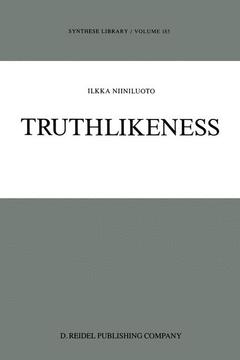Truthlikeness, Softcover reprint of the original 1st ed. 1987 Synthese Library Series, Vol. 185
Langue : Anglais
Auteur : Niiniluoto I.

The modern discussion on the concept of truthlikeness was started in 1960. In his influential Word and Object, W. V. O. Quine argued that Charles Peirce's definition of truth as the limit of inquiry is faulty for the reason that the notion 'nearer than' is only "defined for numbers and not for theories". In his contribution to the 1960 International Congress for Logic, Methodology, and Philosophy of Science at Stan ford, Karl Popper defended the opposite view by defining a compara tive notion of verisimilitude for theories. was originally introduced by the The concept of verisimilitude Ancient sceptics to moderate their radical thesis of the inaccessibility of truth. But soon verisimilitudo, indicating likeness to the truth, was confused with probabilitas, which expresses an opiniotative attitude weaker than full certainty. The idea of truthlikeness fell in disrepute also as a result of the careless, often confused and metaphysically loaded way in which many philosophers used - and still use - such concepts as 'degree of truth', 'approximate truth', 'partial truth', and 'approach to the truth'. Popper's great achievement was his insight that the criticism against truthlikeness - by those who urge that it is meaningless to speak about 'closeness to truth' - is more based on prejudice than argument.
1. Distance and Similarity.- 1.1. Metric Spaces and Distances.- 1.2. Topological Spaces and Uniformities.- 1.3. Degrees of Similarity.- 1.4. The Pragmatic Relativity of Similarity Relations.- 2. Logical Tools.- 2.1. Monadic Languages NL.- 2.2. Q-Predicates.- 2.3. State Descriptions.- 2.4. Structure Descriptions.- 2.5. Monadic Constituents.- 2.6. Monadic Languages with Identity.- 2.7. Polyadic Constituents.- 2.8. Distributive Normal Forms.- 2.9. First-Order Theories.- 2.10. Inductive Logic.- 2.11. Nomic Constituents.- 3. Quantities, State Spaces, and Laws.- 3.1. Quantities and Metrization.- 3.2. From Conceptual Systems to State Spaces.- 3.3. Laws of Coexistence.- 3.4. Laws of Succession.- 3.5. Probabilistic Laws.- 4. Cognitive Problems, Truth, and Information.- 4.1. Open and Closed Questions.- 4.2. Cognitive Problems.- 4.3. Truth.- 4.4. Vagueness.- 4.5. Semantic Information.- 5. The Concept of Truthlikeness.- 5.1. Truth, Error, and Fallibilism.- 5.2. Probability and Verisimilitude.- 5.3. Approach to the Truth.- 5.4. Truth: Parts and Degrees.- 5.5. Degrees of Truth: Attempted Definitions.- 5.6. Popper’s Qualitative Theory of Truth-likeness.- 5.7. Quantitative Measures of Verisimilitude.- 6. The Similarity Approach to TruthLikeness.- 6.1. Spheres of Similarity.- 6.2. Targets.- 6.3. Distance on Cognitive Problems.- 6.4. Closeness to the Truth.- 6.5. Degrees of Truthlikeness.- 6.6. Comparison with the Tichý—Oddie Approach.- 6.7. Distance between Statements.- 6.8. Distance from Indefinite Truth.- 6.9. Cognitive Problems with False Presuppositions.- 7. Estimation of Truthlikeness.- 7.1. The Epistemic Problem of Truthlikeness.- 7.2. Estimated Degrees of Truthlikeness.- 7.3. Probable Verisimilitude.- 7.4. Errors of Observation.- 7.5. Counterfactual Presuppositions and Approximate Validity.- 8. Singular Statements.- 8.1. Simple Qualitative Singular Statements.- 8.2. Distance between State Descriptions.- 8.3. Distance between Structure Descriptions.- 8.4. Quantitative Singular Statements.- 9. Monadic Generalizations.- 9.1. Distance between Monadic Constituents.- 9.2. Monadic Constituents with Identity.- 9.3. Tichý—Oddie Distances.- 9.4. Existential and Universal Generalizations.- 9.5. Estimation Problem for Generalizations.- 10. Polyadic Theories.- 10.1. Distance between Polyadic Constituents.- 10.2. Complete Theories.- 10.3. Distance between Possible Worlds.- 10.4. First-Order Theories.- 11. Legisimilitude.- 11.1. Verisimilitude vs Legisimilitude.- 11.2. Distance between Nomic Constituents.- 11.3. Distance between Quantitative Laws.- 11.4. Approximation and Idealization.- 11.5. Probabilistic Laws.- 12. Verisimilitude as an Epistemic Utility.- 12.1. Cognitive Decision Theory.- 12.2. Epistemic Utilities: Truth, Information, and Truthlikeness.- 12.3. Comparison with Levi’s Theory.- 12.4. Theoretical and Pragmatic Preference.- 12.5. Bayesian Estimation.- 13. Objections Answered.- 13.1. Verisimilitude as a Programme.- 13.2. The Problem of Linguistic Variance.- 13.3. Progress and Incommensurability.- 13.4. Truthlikeness and Logical Pragmatics.- Notes.- Index of Names.- Index of Subjects.
Date de parution : 12-2011
Ouvrage de 525 p.
15.5x23.5 cm
Disponible chez l'éditeur (délai d'approvisionnement : 15 jours).
Prix indicatif 210,99 €
Ajouter au panierThème de Truthlikeness :
Mots-clés :
Karl R. Popper. argue. decision theory. idea. identity. logic. methodology. object. philosophy. pragmatics. reason. semantic. singular. structure. truth
© 2024 LAVOISIER S.A.S.
